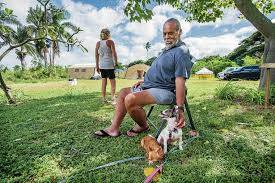HONOLULU — A unique city, state and police homelessness pilot program using inflatable tents at Waipahu Cultural Garden Park and offering short-term shelter 24 hours a day has been a big success in its first two weeks, the Honolulu Police Department said Friday.
The HONU (Homeless Outreach and Navigation for Unsheltered Persons) effort will move every 90 days, with two such camps expected to eventually operate simultaneously, officials said.
“We’ve only been open for two weeks, and we’ve been wildly successful,” said Honolulu Police Capt. Mike Lambert, who came up with the idea and is the department’s point man on homeless efforts. “We’ve already been able to place over 40 people into shelter — which far exceeds what we had hoped for in the opening.”
The next location for the roving shelter, which has a police and outreach presence, may be somewhere in the McCully or Moiliili area, where many complaints have been received about large homeless encampments, Lambert said.
One family of three that was provided shelter in Waipahu included a double-amputee, wheelchair-bound woman who was living on the streets in Wahiawa with her husband and adult son, said Pamela Witty-Oakland, director of the city Department of Community Services.
“She was coming out of Queen’s (hospital) without any place to go on a Friday evening, so we said yes and we helped find them a place to go as a family,” Witty-Oakland said.
That shelter started at the HONU camp because when the woman was discharged, it was too late to go into one of the regular shelters.
HONU is a three-year, $6 million pilot program funded by the state and staffed by the Honolulu Police Department and Department of Community Services. Lambert said the camp always has two to four police and community services employees on duty.
The idea for the temporary homeless shelter grew out of the 2018 Kilauea eruption and triage efforts for people who were displaced.
“We said, ‘Why don’t we do the same thing for our homeless crisis where we create a facility as close to the situation as possible and then we go ahead and triage people and find out what’s the best solution for them in regards to shelter?’” Lambert said.
There is no maximum stay. “It’s basically as long as it takes us to place them, ” he said.
Some established shelters have daytime intake hours only, and that doesn’t always fit the need police have in trying to get people off the streets. HONU has the flexibility to take in people at any time, and provide transportation for them to get there.
“When folks say yes to shelters, if you can’t provide them that shelter right then and there, you have a lost opportunity,” Witty-Oakland said. “This is one of those programs that fills that gap.”
Tents for men, women and families with divided rooms and cots are set up at Waipahu Cultural Garden Park. A mobile shower facility is available, and one meal is provided.
The tent camp, operating off the grid with generators, can be set up in four to six hours. Ten inflatable tents, which can withstand wind gusts up to 75 mph, cost $35,000 each. Down the road, the hope is to add on health services and perhaps “light” mental health and substance abuse assistance.
Lambert said as far as he knows, the program is the first of its kind nationally “where it’s a state-city, police-requested initiative to help with the homeless.”
Over 20 of those who stayed at the HONU camp and were placed in shelters were from Waipahu. Others have come from Kakaako, Pearl City, Ewa Beach and Waianae.
The 90-day stay is used because “we don’t want any one community to feel as if we’ve taken over too much of their park space for a long period of time,” Lambert said.
When the HONU program set up at Waipahu Cultural Garden Park and police gave warnings to homeless along adjacent Waipahu Stream that they were using city space that did not belong to them, the encampment cleared out, he said.
Lambert said that “initially, there’s always apprehension when something new comes to the area — and there were a lot of questions ” from the Waipahu community about the temporary camp.
But he said the early results speak for themselves.
“If you ask anyone, this is probably the safest this park has been in years,” he said.




